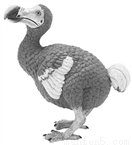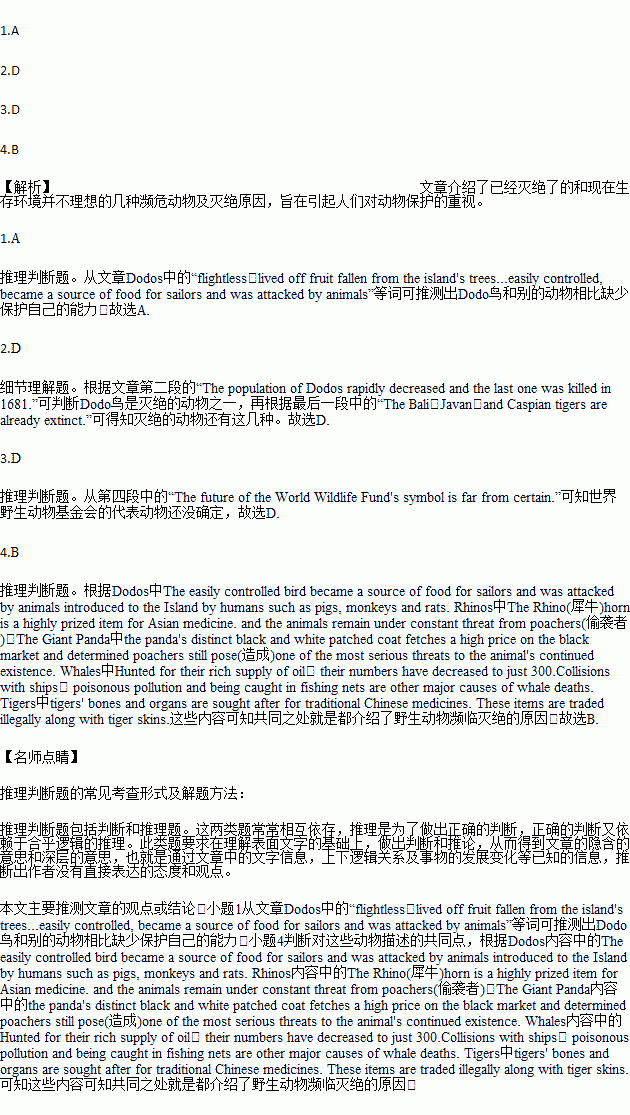题目内容
Animal conservation
Many animal and plant species have become extinct and many more are in critical danger.Finding ways to protect the earth's wildlife and conserve the natural world they inhabit(居住)is now more important than ever.
Dodos

The Dodo is a classic example of how human caused damage to the earth's biology.The flightless Dodo was native to the Island of Mauritius in the Indian Ocean.It lived off fruit fallen from the island's trees and lived unthreatened until humans arrived in 1505.The easily controlled bird became a source of food for sailors and was attacked by animals introduced to the Island by humans such as pigs, monkeys and rats.The population of Dodos rapidly decreased and the last one was killed in 1681.
Rhinos

The Rhino(犀牛)horn is a highly prized item for Asian medicine.This has led to the animal being hunted in its natural habitat.Once widespread in Africa and Eurasia,most Rhinos now live in protected natural parks and reserves(保护区).Their numbers have rapidly decreased in the last 50 years,and the animals remain under constant threat from poachers(偷袭者).
The Giant Panda

The future of the World Wildlife Fund's symbol is far from certain.As few as 1,600 pandas remain in the wild.The Chinese government has set up 33 panda reserves to protect these beautiful animals and made poaching them punishable with 20 years in prison.However,the panda's distinct black and white patched coat fetches a high price on the black market and determined poachers still pose(造成)one of the most serious threats to the animal's continued existence.
Whales

The International Whaling Commission is fighting to ensure the survival of the whale species.Despite the fact that one-third of the world's oceans have been declared the whale sanctuaries(保护区).7 out of 13 whale species remain endangered.Hunted for their rich supply of oil,their numbers have decreased to just 300.Collisions with ships,poisonous pollution and being caught in fishing nets are other major causes of whale deaths.
Tigers

The last 100 years has seen a 95% reduction in the numbers of remaining tigers to between 5,000 and 7,000 and The Bali,Javan,and Caspian tigers are already extinct.The South China tiger is precariously close to disappearing,with only 20 to 30 still alive.Like the Rhino horn,tigers' bones and organs are sought after for traditional Chinese medicines.These items are traded illegally along with tiger skins.
1.It implies that ________.
A. the Dodo lacked the ability to protect itself from other animals
B. sailors to the Island of Mauritius lived mainly on the Dodo
C. the Dodo used to be a strong animal that liked fighting
D. the Dodo,pigs,monkeys and rats were the natives to the Island of Mauritius
2.Which group of the following animals has already ceased to exist according to the text?
A. The Dodo,Rhinos and Giant Pandas.
B. The Rhino,Whales and South China Tigers.
C. The Rhino,Pandas,Whales and Tigers.
D. The Dodo and the Bali,Javan,and Caspian tigers.
3.Which of the following statements is NOT true?
A. The number of South China tigers has reached crisis point.
B. Many animals are threatened with extinction as a result of human activities.
C. People hunt for the endangered animals for high profit.
D. The Whale is the representing mark for the World Wildlife Fund.
4.Which of the following is mentioned in all the descriptions of those wild animals?
A. The way of their life.
B. The reason for their extinction or being in danger.
C. Why they are hunted.
D. Punishment for hunting wild animals.
 名师导航单元期末冲刺100分系列答案
名师导航单元期末冲刺100分系列答案We often close ourselves off when unfortunate events happen in our lives; instead of letting the world soften us, we let it drive us deeper into ourselves. We try to deflect the hurt and pain by pretending it doesn’t exist, but although we can try this all we want, in the end, we can’t hide from ourselves. We need to learn to open our hearts
to the potentials of life and let the world soften us.
Whenever we start to let our fears and seriousness get the best of us, we should take a step back and re-evaluate our behavior. The items listed below are ways you can open your heart more fully and completely.
Breathe into pain
Whenever a painful situation arises in your life, try to embrace it instead of running away or trying to mask the hurt. When the sadness strikes, take a deep breath and lean into it. When we run away from sadness that’s unfolding in our lives, it gets stronger and more real. We take an emotion that’s fleeting and make it a solid event, instead of something that passes through us.
By utilizing our breath we soften our experiences. If we dam them up, our lives will stagnate, but when we keep them flowing, we allow more newness and greater experiences to blossom.
Embrace the uncomfortable
We all know what that twinge(刺痛) of anxiety feels like. We know how fear feels in our bodies: the tension in our necks, the tightness in our stomachs, etc. We can practice leaning into these feelings of discomfort and let them show us where we need to go.
The initial impulse is to run away — to try and suppress these feelings by not acknowledging them. When we do this, we close ourselves off to the parts of our lives that we need to experience most. The next time you have this feeling of being truly uncomfortable, do yourself a favor and lean into the feeling. Act in spite of the fear.
Ask your heart what it wants
We’re often confused at the next step to take, making pros and cons lists until our eyes bleed and our brains are sore. Instead of always taking this approach, what if we engaged a new part of ourselves that isn’t usually involved in the decision making process?
I know we’ve all felt decisions or actions that we had to take simply due to our “gut” impulses: when asked, we can’t explain the reasons behind doing so — just a deep knowing that it had to get done. This instinct is the part of ourselves we’re approaching for answers.
To start this process, take few deep breaths then ask, “Heart, what decision should I make here? What action feels the most right?”
See what comes up, then engage and evaluate the outcome.
Title: Open Our Hearts | ||
Background information | ★Unfortunate events often 1. us deeper into ourselves; ★We can’t hide ourselves 2. the fact that we pretend not to have been hurt; ★We should take a step back and re-evaluate our behavior whenever fears and seriousness 3. us. | |
4. to helping open our hearts | ★Breathe into pain | ★Try to embrace it instead of running away or trying to 5. up the hurt whenever a painful situation arises in our lives; ★Utilize our breath and we can 6.more newness and greater experiences in the future. |
★Embrace the uncomfortable | ★We can practice leaning into the feelings of discomfort and 7.a way out in our lives; ★Running away only8.us experiencing the parts of our lives that we need most. | |
★Ask your heart what it wants | ★To treat the process of decision making from a different9. ; ★See what10., then engage and evaluate the outcome. | |

